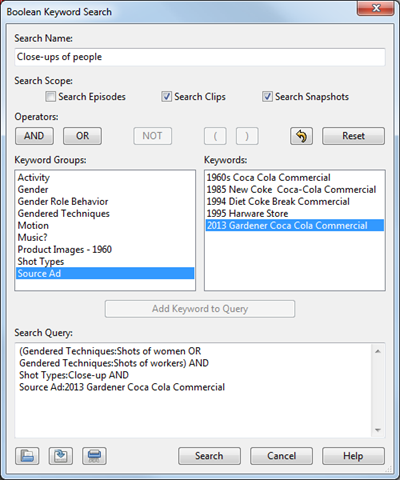Quick Searchers (Section 6.3) allow you to explore the use of a single Keyword within your database. Transana also includes a more sophisticated Search Interface that allows you to create more complex queries into the use of coding in your data.
Suppose that we would like to find close-up shots of the actors in the 2013 Gardener commercial data. We can accomplish this with Transana’s Search functionality, which allows us to use Boolean search terms to construct queries for any coded data in the entire database.
We must first find our codes for all clips containing people – in our model, encapsulated by the Keywords ‘Gendered Techniques : Shots of women’ and ‘Gendered Techniques : Shots of workers’ – and allow for either of these Keywords to satisfy our search criteria. Additionally, Clips must contain the Keyword ‘Shot Type : Close-up’ and the Keyword ‘Source Ad : 2013 Gardener Coca Cola Commercial’. To initiate the search for this, we right-click the Search node and select “Search” from the popup menu to get Transana’s Search Interface. Then we use the buttons provided in the search interface to build our Search Query, specified at the bottom of the form.

To build this query, first, open a set of parentheses and select the first Keyword, ‘Gendered Techniques : Shots of women’, from the list of Keyword Groups and Keywords. (Click the Keyword Group in the left panel to get a list of Keywords in that group on the right.) Then press the ‘Add Keyword to Query’ button. Then press the OR button, select and add the other Keyword, ‘Gendered Techniques : Shots of workers’, and close you parentheses. Then, since we would like to include only those shots of women or workers that are close-up footage, press the AND button and select the ‘Close-up’ Keyword from the ‘Shot Types’ Keyword Group. Finally, add another AND, and select the “Source Ad : 2013 Gardener Coca Cola Commercial” Keyword to limit our search to results from only the desired commercial.
It is important to construct your search queries carefully. For example, omitting the parentheses from this search would cause it to give all clips, from any image or media file, with the Keyword ‘Gendered Techniques : Shots of women’, along with data objects with both the Keywords ‘Gendered Techniques : Shots of workers’ and ‘Shot Types : Close-up’ from our Gardener ad, because AND operators are carried out before OR operators, all things being equal. It is generally a good idea to use parentheses liberally to ensure that your searches are being carried out precisely as you want them to be.
Transana’s Search interface is very carefully designed to prevent illegal searches from being conducted. If the Search button on the Search Dialog is not enabled, you can be sure it is because the search you are trying to specify is somehow improper. Missing parentheses and trailing Boolean operators are the most common causes of invalid search specifications.
You may label and save a search to reload later by using the buttons in the bottom left corner of the Boolean Search window. It is often helpful to be able to repeat a search as you add data to your database, code media files for new information, or make other changes.

Transana returns the results of the Search operation in the form of a tree structure under the main Search node in the Database Tree. As described in the Quick Searches section (6.3), a Search Result acts very much like a Collection, allowing you to explore and manipulate the data returned by the Search in a variety of ways as you try to decide whether the search has returned meaningful information. Manipulating the Search Result in the database tree does not affect the underlying data in Transana, although loading Clips and Snapshots and manipulating them can.
We might want to compare these search results with another similar search. If we wished to omit shots of people consuming Coke products from these Clips, we could use the following Boolean operation to do so. Simply add an AND NOT operator, followed by the Keyword you’d like to leave out, in this case ‘Product present’ under ‘Shot Types’.

Note that a NOT statement must be preceded by either an OR or an AND; OR NOT statements can be used to add all Clips without that Keyword to the search results, and this is only rarely useful. Further information is available in Transana’s Manual.
Our comparison between these sets of search results can occur in several ways. One of these is to simply compare results in the Search portion of the Database window. Right-clicking the search output offers a report in the form of the Search Collection Results. This functions identically to using a Collection Report.
Should you want to save the results of a Search for future Transana sessions, you can create a Collection out of a Search result by right-clicking the Search title and selecting the ‘Convert to Collection’ menu item. Note that this will duplicate all Clips in your search results.



